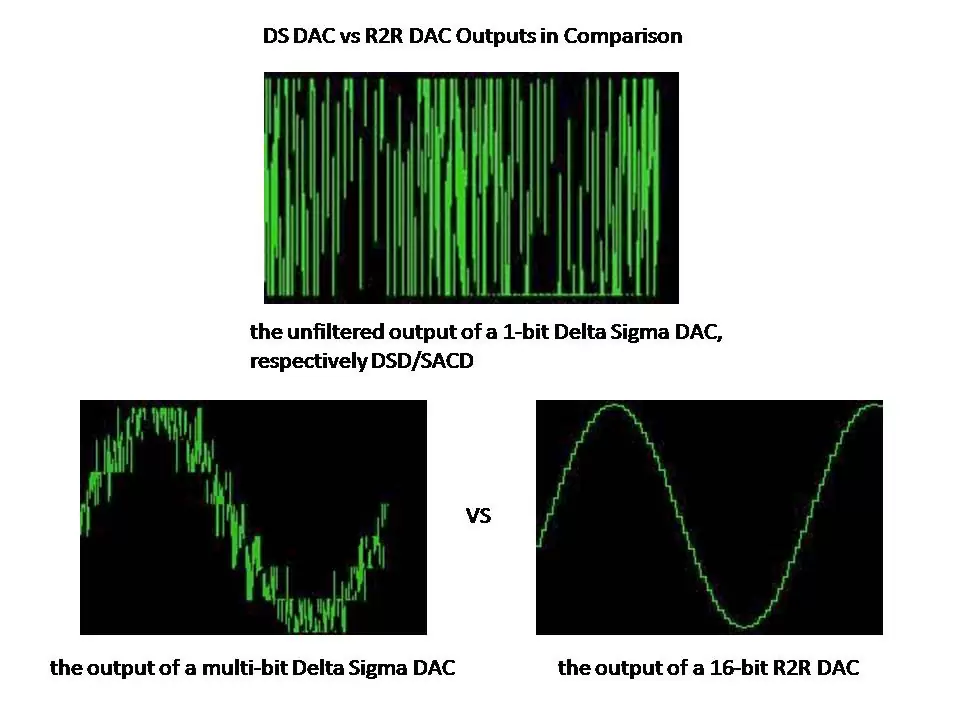Uncovering the Best DAC Design for Audiophiles: Delta Sigma vs Non-Oversampling (NOS) R2R
- Alexander aka KUBIK
- Feb 6, 2024
- 4 min read
Updated: Feb 12, 2024
What DAC's Design Is Better And Why Better for You?
- Delta Sigma (DS) DAC
- R2R (Resistor Ladder) DAC
Reflecting on digital-to-analog conversion concepts, the ongoing discourse between Delta Sigma (DS) and R2R (resistor ladder) DAC designs continues to intrigue audio enthusiasts and professionals alike. The fundamental question of which is superior often leads to a quagmire, as the theoretical debate faces the challenge of numerous implementation variables in DAC design – an analog to the futile endeavor of proving the inherent superiority of apples over pears.
To truly assess the merit of each design, it becomes imperative to transcend theoretical discussions and delve into the realm of practical experience. Comparing the sonic signatures of a well-crafted DS DAC with a meticulously designed Non-Oversampling (NOS) R2R DAC, such as the widely recognized TDA1543, unveils the distinctive and naturally musical character of the latter. Those who have embraced the unique qualities of a digital filterless R2R design understand its enchanting sonic allure.
However, it's crucial to acknowledge that the DAC chip alone does not dictate the entire listening experience!
Surrounding elements, including power supplies, the I/V conversion stage, the SPDIF receiver (if present), and the output stage, contribute significantly to the final output. In the practical realm, the complexity deepens further. The circuit's design, the careful selection and combination of components around the DAC chip, and the digital transport – whose role is as pivotal as the DAC itself – collectively shape the audio experience.
In this intricate web of variables, the pursuit of audio perfection transcends the narrow confines of DS versus R2R debates. Rather, it emphasizes the holistic orchestration of components and design choices that harmonize to create a symphony of sound. Thus, the exploration and appreciation of digital-to-analog conversion extend beyond theoretical postulations, inviting enthusiasts to engage in the rich tapestry of practical implementation where each element plays a nuanced role in crafting an auditory masterpiece.
The distinctive qualities of R2R DAC designs, particularly those emphasizing non-oversampling (NOS) configurations, stand in stark contrast to their Delta Sigma (DS) counterparts, sparking an ongoing debate in the audio community. The essence of this debate transcends theoretical discussions, finding resonance in the practical experiences of enthusiasts.
Drawing an analogy to photography, the comparison between R2R and DS is likened to images captured with optical lenses versus those subjected to digital zoom and extensive post-processing. A well-designed NOS R2R DAC is lauded for its ability to present music with depth, organic textures, and a natural flow, akin to the richness found in pictures taken with proper optical lenses.
The theoretical superiority of DS chips, evident in their specifications, often falls short in practical applications. While DS DACs boast impressive accuracy numbers post-modulation, achieving these figures in real-world scenarios proves challenging due to factors such as power supply quality and imperfections in components and materials. The clever concept of oversampling, demodulation, and noise shaping employed by DS DACs comes at a cost, particularly in terms of musicality.
The critical examination of DS DACs reveals their reliance on oversampling, which involves interpolating missing data and subsequently noise-shaping and filtering. The resulting sound is characterized by clarity and perceived details, yet it often lacks the natural coherence and precision found in music. The use of a negative feedback loop in DS designs introduces phase and amplitude distortion, adversely affecting the emotional engagement of the listener.
In contrast, NOS R2R DACs, devoid of digital filtering, offer a more natural and musically alive experience. While both DS and R2R designs grapple with imperfections inherent in digital-to-analog conversion, the absence of digital filtering in NOS R2R designs contributes to their distinctive sonic character.
The perceived weaknesses of NOS R2R DACs, such as a lack of resolution, are mitigated through meticulous component selection and circuit optimization. The impedance mismatch inherent in DAC designs is also addressed through innovative approaches, such as using a single transistor for I/V conversion and a class A, zero-feedback valve output stage.
In the quest to determine what is truly superior, the evaluation extends beyond theoretical considerations. The comparison hinges on the critical assessment of real-world examples, inviting listeners to discern between a NOS R2R DAC's brute force, real-time resolution, and a DS chip's filtered pink noise manipulated by algorithms. The conclusion leans toward the subjective experience, where the musicality of NOS R2R designs often surpasses that of modern DS counterparts, offering a timeless and analog-like sonic richness.
The inherent musicality of NOS R2R designs, when coupled with meticulous circuit implementation and high-quality components, defies the notion of obsolescence. The analog-like sound and natural timbres found in NOS R2R DACs prompt a reconsideration of progress in audio technology, suggesting that the charm of established and optimized technologies may rival or even surpass the latest innovations.
Ultimately, the judgment rests in the ears of the listener, inviting them to appreciate the timeless elegance of well-crafted NOS R2R DACs in the ever-evolving landscape of audio technology.
Links:








